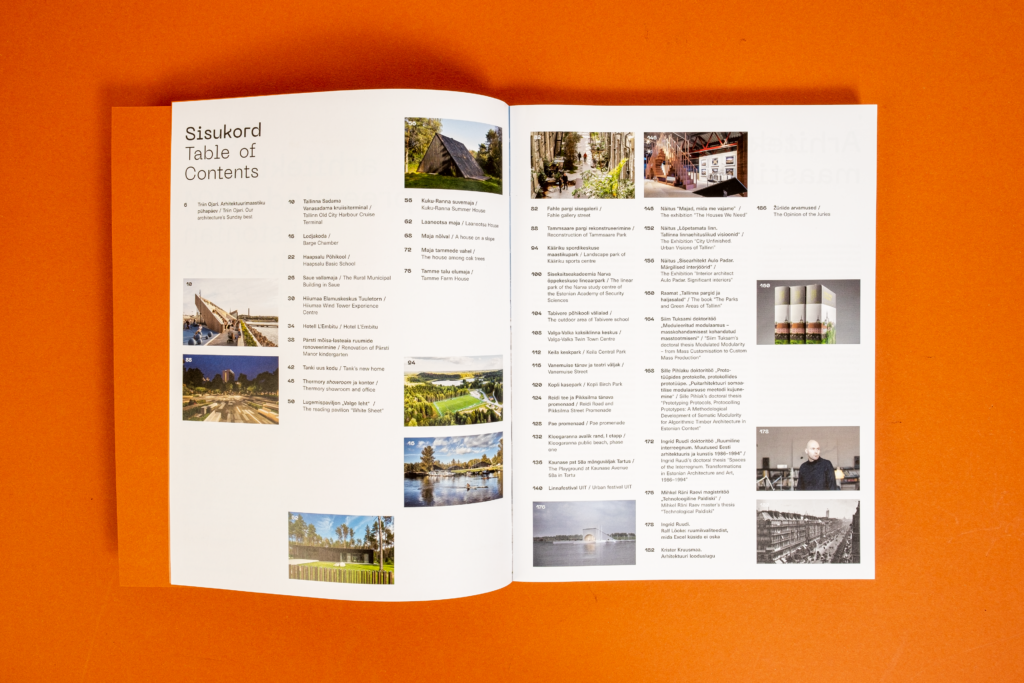Our architecture’s Sunday best
The yearbook provides an overview of the awarded architecture, our built environment’s Sunday best. We have brought together the projects, buildings, interiors, landscaping, exhibitions, books and articles nominated for altogether six awards. The prizes awarded by the Cultural Endowment, Estonian Landscape Architects’ Union, Estonian Association of Architects and the article award by Sirp and Maja are all based on their own statutes (for instance, the residential architecture award is given out every other year) and so the featured objects have been completed within the past three years, though mainly between 2020 and August 2021. There were altogether 36 nominees as well as one prize for a student work and two for articles. Summaries of the works and comments by the juries are given at the end of the book, none of them could complain about the shortage of good nominees.
As expected, the public buildings commissioned by the public sector have taken the crown – Lodjakoda in Tartu, Haapsalu Basic School, Saue Parish Administrative Office, Experience Centre Windtower in Hiiumaa and even the small reading pavilion in Koidula Street in Tallinn. So, we are all the more pleased to see the listed company Tallinna Sadam investing in architecture – awarded the main prizes of both the Cultural Endowment and the Estonian Association of Architects, the cruise ship terminal in Old City Harbour is a building and a landscape at once, marking a strategically proper step for bringing the seaside area closer to people. As if a piece at the edge of the puzzle has found its right place! “It is true that with every project we devise ways for the designed building to draw from its environment everything that it possibly can and always give back something which is not prescribed by its primary function,” was said by one of the architects of the terminal Ralf Lõoke in his interview to MAJA. He says that despite everything, it is important to experiment in order to create something new. The terminal is certainly a living proof of his words. Incidentally, the given interview by Ingrid Ruudi was also awarded the prize for the best article, and indeed, it does not happen too often that we come across such accounts of an architect’s practise in their own express wording.
The selection of the residential architecture nominees reflects our yearning for a house in the midst of nature, sometimes it is the family’s second home away from the city or a private house in a peaceful suburb. Timber, simple geometrical forms, light and seamless connection with the outdoors – we have actually seen it all before, however, its continuous return features increasingly more polished, detailed and cleaner forms. One of the winners, Kuku-Ranna cottage, is also an attractive reference to the Soviet summer house architecture with the shutter system adding a contemporary twist to the legendary tent-type building.
The number of great works in the landscape architecture nominee list has increased year by year. The Landscape Architects’ Union has numerous award categories and so also the given book has been filled with greenery – beaches, playgrounds, promenades and parks. The green areas relate to leisure, relaxation, restoring our energy levels and possibilities for play, so we find them appealing with no reservations – parks are always lovely, particularly now that they embody the notion of carefree and mask-free spaces. One of the winners, Tammsaare Park in the heart of Tallin, is perhaps the most spectacular of the park solutions, the vainest section of the glam zone in the city centre that tends to provide a short pause for the hurrying individuals rather than more general peace and quiet. Also another winner, the indoor gallery of Fahle Park, the first of its kind in Tallinn, provides a place for a pause. It is a former street now equipped with a glass roof, full of exotic plants, chairs and tables, water features, tiny bridges and other attributes ranking high on the cosiness scale. The common denominator for both winners could be urban escapism complemented by the third winner – the minimalist and natural design of the landscape park in Kääriku.
The title of this year’s Venice Architecture Biennale (announced prior to the pandemic) “How will we live together?” characterises the current era quite well – what are safe spaces like, how can we live together with artificial intelligence, what would relieve our passion for consumption, how can we consider other life forms and creatures, in other words, biodiversity in our urban public space? The curator of the winner of the exhibition award “Houses that we need” at the Estonian Museum of Architecture asked if we need new buildings at all and if the radical spatial transition as a solution to the global crisis is even possible? We may dream but the cart will continue to roll at its own space as architecture is a slow form of art, as we know. The positive emotional load provided by good new buildings, squares, parks or exhibitions is certainly a value in its own right, so let us enjoy it not only by browsing the book but also by visiting these places!
Triin Ojari









































































































































































































